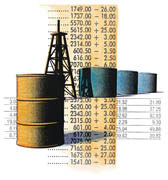Oil prices swung wildly this week, rising to near 30-month highs after Saudi Arabia sent troops to Bahrain, then plummeting to less than $100 a barrel on expectations that an earthquake-ravaged Japan would demand less oil.
The ride is not over yet, say economists and Wharton professors: There may be ups and downs, but long term, high oil prices are here to stay. On top of volatility caused by natural catastrophes and political upheavals, a tight oil supply and increasing demand promise to keep driving prices up steadily over time. Prices could fluctuate between $60 to $200 a barrel, but probably will not go back to $30 or $50 anytime soon, says Wharton management professor Witold Henisz. Higher prices “are going to be part of the environment for the next few years. There just isn’t a lot of surplus oil.”
Supply and demand are just part of the equation: Fear of a future squeeze also drives prices higher than they should be. That is not good news for a fragile economy struggling to reemerge from a crippling recession, but most experts are not predicting a double-dip just yet. That would require a sustained period of oil prices north of $125 a barrel — or another disaster in an oil-rich part of the world.
The fallout from the 8.9-magnitude earthquake and tsunami in Japan has added to oil market confusion. “Oil prices are being pulled in two opposite directions,” says Bernard Baumohl, chief global economist at the Princeton, N.J.-based Economic Outlook Group and author of The Secrets of Economic Indicators: Hidden Clues to Future Economic Trends and Investment Opportunities. “The disasters in Japan are pulling prices down in anticipation of slower Japanese growth in the short term, and because their oil refineries are damaged and thus [they] will order less crude oil. Lifting prices higher, however, is the civil unrest in Bahrain now that Saudi Arabia and other Gulf nations have sent troops into Bahrain. The net result will still be higher oil prices because of the fear that Saudi Arabia is now completely encircled by countries that are unstable. Expect oil to remain in triple digits and gasoline prices to stay above $3 for the rest of the year.”
Every $10 increase in price per barrel translates into about a 25-cent increase per gallon of gas. Before the Japanese earthquake, the U.S. Energy Information Administration forecast a gallon of gas to average $3.56 in 2011, with a 25% chance that gas could top $4 during the summer.
Every penny increase in gas prices drains $1 billion out of the economy each year, according to Baumohl. At this point, rising oil prices are “not having a material effect on the economy,” he says, but “once gasoline prices begin to exceed $4 per gallon, the stress becomes greater.” If gas prices increased to $4.50 per gallon for more than two months, it would “pose a serious strain on households and could put the entire recovery in jeopardy. Once you get above $5, [there is] probably above a 50% chance that the economy could face a downturn.”
That is not likely to happen unless there is a major disruption in Saudi Arabia, notes Wharton finance professor Jeremy Siegel. Based on the amount of oil the U.S. imports, every $10 increase in the price of oil equates to about a quarter of 1% of the country’s gross domestic product (GDP), he says. That isn’t enough to send the economy into freefall. “If oil stays at its current level, it won’t produce a recession,” he predicts.
Even if oil prices do keep rising, the pain probably will not be as severe as the oil shocks of the 1970s, according to Siegel. In the first place, the energy intensity of the U.S. economy — that is, the energy required to produce $1 of GDP — has fallen by 50% since then as manufacturing has moved overseas or become more efficient. Also, the price of natural gas today has stayed low; in the past, oil and gas moved in tandem. And finally, “we’re closer to alternative sources of energy for our transportation,” Siegel says, “which would be accelerated if oil really moved up.”
‘Oil Has Lagged’
Short term, there is little the government can do to mitigate the impact of rising oil prices on the economy. Wharton experts agreed that rising oil prices are not enough of a reason to tap into the U.S. Strategic Petroleum Reserve, a cache of 727 million barrels of oil stashed in man-made salt domes in Texas and Louisiana. In recent weeks, both Democrats and Republicans have called for the government to consider using some of the reserve to help ease gas prices.
The government “definitely shouldn’t do that,” even if prices rose above $150 a barrel, says Wharton finance professor Franklin Allen. The Reserve was designed as an emergency fund in the case of a sudden disruption in oil supply, not as a way to mitigate oil prices, he notes. “It’s a month supply. If something drastic happened in Saudi Arabia, it would be for that. They shouldn’t touch it now.”
Fighting rising oil prices with monetary policies is also tricky. The Federal Reserve on Tuesday chose to take no action in response to oil prices, calling the rise “transitory.” “Commodity prices have risen significantly since the summer, and concerns about global supplies of crude oil have contributed to a sharp run-up in oil prices in recent weeks,” the Fed said in a statement on March 15. “Nonetheless, longer-term inflation expectations have remained stable, and measures of underlying inflation have been subdued.”
That is probably the right move, according to Wharton finance professor Richard Herring. “The 1970s taught us that trying to facilitate an oil price increase via inflation just doesn’t work. It could lead to stagflation,” he says. “If it’s a real change in the price of oil, there’s not much we can to do combat it.”
Herring is surprised that oil prices have not actually gone higher, given continued demand for oil from emerging markets. Over the past decade, rapid growth in Asia has fueled an increased need for all sorts of commodities, from copper and silver to agricultural products. “They’ve all gone up a lot more than oil,” Herring points out. “You could actually make the case that oil has lagged.” The long-term demand for oil is unlikely to slow down, he predicts. “Once you start putting two billion more people on the roads, as we are in India and China, even if they use just a fraction of the energy we do, it’s bound to be a huge impact on the market.”
Oil prices today behave differently than they did 15 years ago, according to Robert Ready, a Wharton Ph.D. student who studies the oil futures markets. In the past, a natural disaster or political turmoil might drive oil prices up momentarily, but there was always enough global supply to compensate; if one oil-producing nation went offline, another would step in to meet global demand.
“In the last 10 years, there [hasn’t been] enough oil supply to respond to a change in price,” says Ready, who will become a professor of finance at the University of Rochester’s Simon Graduate School of Business in July. According to Ready, when discussing oil markets, supply does not refer to how much oil is left in the ground, but how much oil can be produced at any given time. After increasing for several decades, total world oil production has been roughly flat since 2004. Since then, oil prices have behaved differently: They tend to go up and stay up. “In the past, if they went up, you would expect them to go back down — but they don’t go back down anymore,” he notes. “At some point, there just wasn’t enough production to keep up with increasing demand.”
An Unpredictable Future
Embedded in the most recent spike are fears of a future drop in supply, stemming largely from social unrest in North Africa and the Middle East. Chris Lafakis, an economist at Moody’s Analytics who specializes in energy, calculates that “the fundamental price of oil should be $93 to $94” based on naked supply and demand. But due to uncertainty in so many oil-producing countries, his forecast for 2011 has the price of oil hovering around $98 a barrel, which includes the fundamental price plus a $5 per barrel “uncertainty premium” that he expects to evaporate when crises resolve.
The problem is that nobody knows when that will be. The political upheaval that began in February in Tunisia and led to the ouster of Egypt’s President Hosni Mubarak has thrown a question mark over the entire region. Ongoing rebellion against dictator Muammer Gaddafi has disrupted oil production in Libya, which pumped out 1.6 million barrels each day before the crisis hit. Fears about further instability in the region increased Monday after Saudi Arabia and the United Arab Emirates sent troops to quell protests in Bahrain, increasing tensions with Iran. Saudi Arabia, the world’s largest oil producer, is still working to stave off its own protests: a “Day of Rage” scheduled for March 11 fell flat, but another is planned for March 20.
Escalation of unrest could cause prices to spike, according to Lafakis. If oil production were to shut down in Libya, Bahrain and Yemen, for example, the price could jump to $125 per barrel. Take out half of Iranian production, and the price jumps to $150. “And if we lost half of Saudi Arabian production, the price would go to $200 overnight,” Lafakis says. “These are low probability events. But they would have catastrophic consequences.”
Any predictions about what will happen next are “pure speculation,” says Howard Pack, a business and public policy professor at Wharton and co-author of The Arab Economies in a Changing World. “This story is in its early stages,” he notes. “It’s all very unpredictable.” Arab countries are buckling under a bulge of college-educated youth who can’t find jobs and are frustrated with stagnant autocracies. But even if popular uprisings overthrow current regimes, new leaders may not know how to move the countries forward. It is not clear, for example, whether Egypt’s military will take on the types of economic reforms that the country needs. “These countries with new governments might end up looking more like Eastern Europe from 1990 to 1996 [after the fall of Communism in the region], when GDP went down by 30% to 40%,” Pack points out.
The earthquake in Japan has thrown another puzzle piece into the mix. Japan is the world’s third-largest oil consumer behind the United States and China, and the world’s second-largest net importer. The devastating earthquake and tsunami that hit Japan on March 11 shut down a quarter of the country’s refining capacity and 11 of its 54 nuclear reactors, according to Reuters. Workers are still scrambling to stabilize four damaged reactors at the Fukushima Daiichi nuclear complex in northeastern Japan.
In the immediate aftermath of the catastrophe, Japan’s demand for oil will probably go down, Pack predicts. But longer term, a backlash against nuclear energy — in Japan and beyond — could drive oil prices back up again. “There may be more reluctance to have nuclear power plants,” Pack says. “That could have a very big effect on demand.”
Oil pundits wonder what is coming next. Wharton’s Henisz, who has studied oil company initiatives to improve community relations in several African nations, is keeping an eye on other oil-rich countries. “We’re all focused on the Middle East and North Africa, but a lot of the same conditions exist in Equatorial Guinea, Angola and Nigeria,” he points out. “I’m not saying they’re going to go like dominoes, but it takes uncertainty about [just] one of them to create a real problem.”



